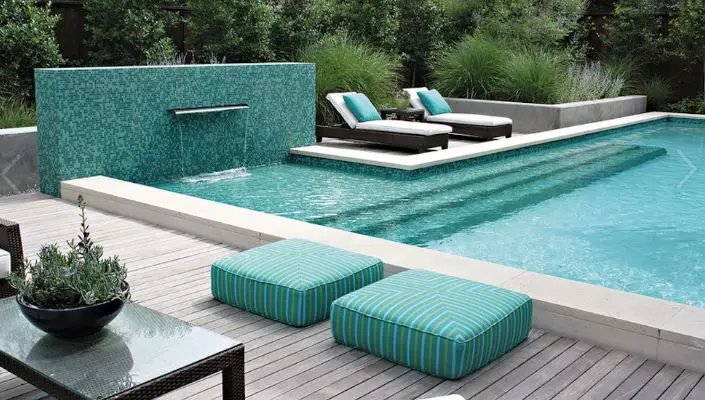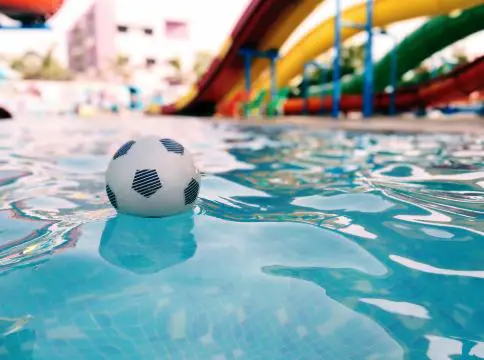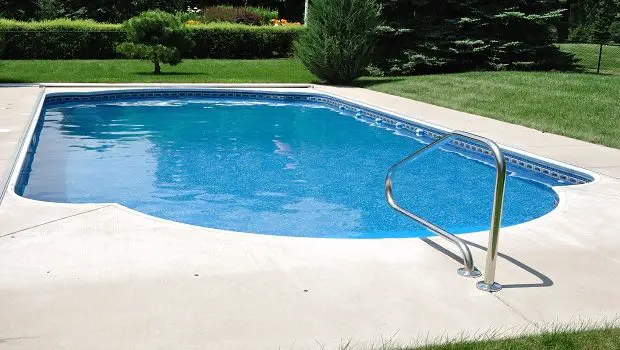How to Open Your Inground Pool in 12 Easy Steps
DISCLOSURE: As an Amazon Associate, I earn from qualifying purchases.
It’s that time of year again! The pool season has arrived.
The sun is shining. Temperature is rising. Let’s go for a swim!
There you are, standing on your terrace, staring at a pool cover, wondering what type of horrors await you below.
to open inground pool seems like too much work…
Don’t worry. Grab a pal and a few essentials – and read this article – and you’ll be back to backstroking in no time.
Getting Ready to Open Your Swimming Pool

Before you begin, you will want to be sure you’ve got all of the tools you want to be gathered poolside and ready to go.
You will probably have a lot of these items on hand, such as a garden hose, but you may need to get a couple of others, including (and especially) the right protective gear.
Each year, hundreds of pool owners end up in emergency rooms because of poisoning from pool chemicals. The majority of accidents occur because people do not use protective gear when working with pool chemicals.
So when you’re gathering all of your other supplies, do not neglect safety gear. It matters.
Ok, so this is what you’ll need to open your pool properly:
- Pool cover pump
- Soft broom
- Car wash soap or winter cover cleaner
- Start-up chemical kit
- Pool gasket lubricant
- Thread seal tape
- Skimmer on a telescoping rod
- Garden hose
- Pool brush
- Safety goggles
- Chemical-resistant gloves
- Pool shock
- Test strips
- A friend to assist.
Start-Up Chemicals

Based on the results of your water test, you may need pool chemicals along with shock to balance your water chemistry.
You can buy a start-up chemical kit that includes all you need.
Or, even better, first, test your water then purchase the compounds your pool requires.
Chemicals you may need include:
- Chlorine
- Calcium hardness increased
- Alkalinity increaser
- pH increased
- pH decreased
- Metallic sequestrant
- Water clarifier
- Algaecide
How to Open Your Inground Swimming Pool
You won’t need to wear protective gear in these steps. Don’t wear your safety goggles just yet.
However, you may want to slather on the right amount of sunscreen.
1. Remove Dirt & Debris From the Pool Cover
Use a soft broom to sweep off dead leaves and other debris from your winter cover.
Then use your pool cover pump to eliminate any standing water from your cover.
Some pumps can be a little bit slow at drawing water, while others will suck up dust particles and everything else that comes in their way. Know your pool cover pump capability, so you don’t overwork it.
2. Remove the Pool Cover
Ask your friend to stand on the opposite side of your pool to help you lift and fold the cover back and forth, similar to an accordion.
Just when you are to open inground pool, it is an excellent time to inspect your cover to see how it fared over the winter. If it’s damaged, now is the time to replace your pool cover. And of course, if it is beyond help, you can skip the pool cover storing and cleaning. Win-win!
3. Clean and Store the Pool Cover
With your cover folded up, have your buddy help moves it to your yard and spread it out flat.
This little step will make cleaning your pool cover easier. Use a car wash soap or pool cover cleaner and a soft broom to scrub it lightly.
Avoid using harsh chemical cleansers or any sharp or abrasive tools, which might ruin your pool cover.
Rinse away all the soap or cleaner.
Dry the cover with a towel or leaf blower. Store the cover within a storage bag or secure container with a lid.
Your pool cover is clean!
Note: Don’t store your pool cover on the floor or the ground of your garage or shed. That is an invitation for rodents, bugs, and other insects to make their home in it over the summer. Then, when it is time to close your pool, you will be purchasing a new cover.
Tip: If you use water weights, drain them, and let them dry completely before storing.
4. Skim the Pool
Use your skimmer to catch anything that fell from the cover during removal and some large debris that may clog your filtration system when you turn it back on.
Getting all the big stuff out will make the remaining cleaning tasks easier.
5. Remove the Ice Compensator and Plugs
When you closed your inground swimming pool for the winter, you blew out the pipes and connected winterizing plugs to stop water from entering back into them and freezing (…right?).
So, now you have to walk around the pool and remove the plugs.
You’ll see some bubbles as the pool water runs back into the pipes. This is normal.
Whether you use a soda bottle or an ice compensator, you will want to eliminate it and the winterizing plugs of your skimmer.
6. Reinstall Chutes and Ladders
Do you have a diving board, pool ladder, step rails, slide, or other accessories that you removed for the winter?
Reinstall the things you eliminated at the pool season’s end.
Tip: This is a great time to grease bolts and lubricate your diving boards hinges.
7. Add Fresh Water
You may have lost a few inches of water over the season, even with a winter cover.
While the cover does provide some protection from evaporation, its primary purpose is to keep things out of your pool–not really to keep the water in it.
Make your water level up to standard to avoid needing to balance your water chemistry twice.
Water first, chemicals, and filtering after.
Make sure to use a hose filter to block metals and other debris from getting into your pool.
8. Run Your Pump and Filter
Reinstall the drain plugs on your filter and pump using thread seal tape. Grease any O-rings using pool gasket lubricant to preserve them.
Apply the same lubricant on your pump casing O-ring. If you find cracks in that O-ring, replace it instantly to avoid sucking air into your pump.
Your chlorinator and pool heater, if you have them, also have drain plugs.
Next, open your backside valves to ensure the water being drawn into your pump has somewhere to go.
If you have a multiport valve, switch the handle to waste and substitute the sight glass, air bleeder, and pressure gauge.
Turn your circuit breaker, then turn on your pump.
Once water is running, your pump is primed. Have a look. Wash or replace it, if needed.
Turn your multiport valve to filter mode.
If you used antifreeze when you closed your pool, this procedure expels it from the lines. Most of it’ll come out while the valve is switched to waste, but a little of it might still make it into your pool water. Do not be concerned.
The antifreeze made for pools is non-toxic, as well as the rest of it will be filtered out in following filtering cycles.
9. Turn That Heavy Metal Down
It might seem counterintuitive, although your pool water sat stagnant throughout the winter, metal levels might have increased.
You also probably topped off your pool with tap water. We hope you used a hose filter to keep those minerals out of your pool.
But to prevent the staining and buildup due to any metal in your pool water, add a metallic sequestrant.
10. Balance the Water
Though you may use your typical test strips, you might want to conduct a water sample to your pool supply store when you start your swimming pool for the season.
This will give an accurate baseline to work from for the rest of the season.
Once you understand what needs adjusting, begin balancing your water.
Keep in mind; basic pool chemistry asks you to maintain alkalinity first, then pH, and finally, calcium hardness.
Avoid adding any chemicals you do not need.
11. Brush and Vacuum the Pool
You don’t need to brush your pool at this time, but it might help head off algae issues while helping your pool shock be more effective.
If you have got the time, brush your pool surfaces.
Then, vacuum your pool manually to pick up any sediment left in your pool floor.
12. Shock That Pool!
To kill bacteria, algae spores, and make your water clean, you will want pool shock.
Efficiently shocking your pool need you to reach something called breakpoint chlorination, which you can compute based on free chlorine levels from the water test.
We suggest double shocking at pool opening.
To double shock, you will use two pounds of chlorine shock in 10,000 gallons of water.
Before you put chlorine to your pool, you will want to don your safety goggles and chemical-resistant gloves.
Do not pour shock into your filter basket as it may cause damage.
You can put shock right into your pool water, gently, as you walk around the perimeter of your pool.
You might also pour some water into a 5-gallon container, then melt the shock in the water. Drain the solution right into your pool.
Caution: Placing several types of shock in the same bucket, even if you’ve rinsed it between uses, might be explosively vulnerable.
Never use the same bucket for different chemicals, if you use the bucket method.
13. Filter, Filter, and Filter More
All your work is done!
Leave your filtration system running for a minimum of 24 hours to mix up the shock and filter left dead algae spores, debris, and any other gunk.
By the following day, Your pool should be clean and ready for swimmers day. If
It looks a bit cloudy, which might be from the shock.
You can either wait longer for it to dissipate or add a dose of pool water clarifier to clean it more quickly.
Safety Is Priority Always
To assure everyone’s safety in and around your pool, take a couple of steps before using your pool after you have opened it.
Spray your pool deck complete with a hose to wash away any chemicals that might have dropped where swimmers could move inside them.
Test your water to ensure chlorine levels are decent, and water chemistry is stable.
Swimmers develop or could get sick rashes if your water chemistry and sanitizer levels are incorrect.
Similarly, you should test your smoke and carbon monoxide detectors regularly, make sure you check all of the safeguards around your pool area, such as door alarms and gate locks.
If anything is not working correctly, fix it as soon as possible.
Put your winter cover somewhere children or animals can’t climb in and get trapped.
Storing it in a durable container and away from sunlight will ensure it works effectively next winter.
Store your chemicals safely and away from children and pets so that they won’t lead to a health hazard.
Keep them in a cool, dry place in their original packaging.
Make sure the containers are closed properly.
The Pool is Open!

When you’re standing alongside your pool needing water and the debris on the pool cover will disappear, remember that with a little work, by this time tomorrow, you could be swimming in crystal-clear water.
Open your swimming pool the ideal way, and you’re going to set the stage for easy maintenance throughout the rest of the season.














